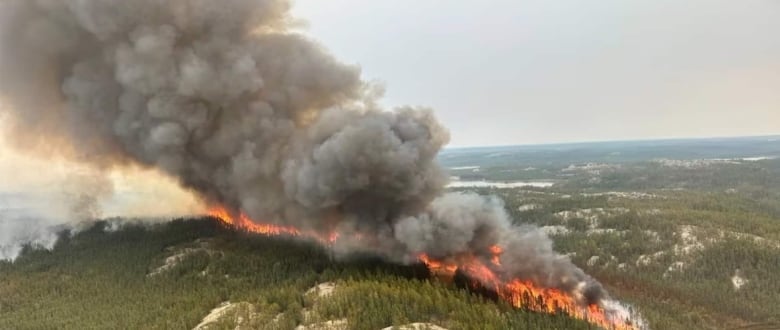Residents were told to evacuate the northern Canadian city by Aug. 18.

Yellowknife officials move to help homeless residents as city reopens
Weeks after the city was evacuated due to dangerous wildfires, Yellowknife residents are trickling back in, including those without homes of their own. Local agencies are now preparing supports, including meals and temporary shelter.
As the re-entry to Yellowknife continues, work has been underway to track down and arrange for the return of the city’s homeless population.
The last homelessness count in the city found there were approximately 300 people who identified as homeless, of which roughly 100 stay in shelters every night, according to Tony Brushett, the executive director of the Yellowknife Salvation Army.

When the evacuation order came down mid-August for everyone to leave the city, some clients left with family or friends while others were flown to various cities, such as Calgary, Brushett said.
Now that the city has reopened, the agency said there have been challenges in tracking people down at hotels or shelters to organize a way home.

“It is much more challenging because, in some cases, there’s individuals who may not have a cellphone or a cellphone that’s working,” said Derek Pluchinski, program manager for the Yellowknife Salvation Army.
“When they were dispersed from Yellowknife, they got on a plane and went to various locations. And due to privacy and confidentiality laws and so forth, it’s very difficult to find people or to even get confirmation of their whereabouts in certain cases.”
Pluchinski said the clients he has talked to are anxious to get home.
“They want to be in their familiar space on their land. One gentleman told me, he says, ‘You know, I just want to go up on one of the hills and see the lakes and see the trees and be home,'” he said.
“For many of them, it has been an intimidating experience, somewhat scary for them to be in a big city.”

Dave Kanayok, 39, stayed at a hotel and shelter in Calgary during the evacuation order and while he said he did not mind being in the city, he was eager to go home.
“I could go see my friends again … and see my cousins and my family there,” he said.
“I can’t wait to go back to Yellowknife.”

Evacuees return to Yellowknife but the threat of wildfire remains
Wildfire evacuees are returning to a mostly unchanged Yellowknife three weeks after they were forced to flee. But the signs of the fires are still there with the outskirts scarred by firebreaks, smoke lingering in the air and the threat of more potential fires not far away.
Meanwhile, Brushett said staff have been working the last few days to clean and get facilities back up and running.
There is also an emphasis on making sure there are supports in place for clients when they return.
“For some, I’ve heard, ‘I’ve enjoyed my vacation’ … But for those who were put south, now they’re put back up here again and they’re probably, in their own mind, wondering, ‘What just happened to me?'” Brushett said.
“We’re going to make sure that we have staff available to talk with them and, more importantly, listen to what their concerns are.”
Lessons learned for youth shelter
The evacuation, while difficult at times, has provided some valuable lessons to Home Base Youth Centre, the local youth shelter.
While some youth left Yellowknife on their own, executive director Tammy Roberts said 17 young people and one baby stayed with staff and evacuated to Zama City, a small northern Alberta community — an intentional move on the part of staff.
“We know our youth and they’re so drawn to the street and so vulnerable that, without having that control in a bigger centre where we wouldn’t know how to find them or support them or look for them, it would have been so stressful,” she said.
The last three weeks were packed with activities, such as swimming, arts and crafts and time with elders.
“It was actually such a great opportunity to bond with them, for the staff and the youth to bond with each other … Just having that routine and that schedule was so important for us to keep them busy,” Roberts said.
Now, special care is being taken with the transition back.
“[The youth] really liked having people 24/7 to talk about relationship problems that they may be having or challenges with family dynamics,” she said.
“We’re dedicated to try and keep that consistency and connection going with the youth because they’re used to it.”
Wyatt Causa, 21, has been with Home Base for three years and was one of the young people in the group in Zama City.
Causa said he passed the time playing video games, playing pool, going for walks and using the gym.
Now that he is back, he is relieved to be back in familiar territory.
“I’m just happy to be back in general,” he said.
ABOUT THE AUTHOR
Julia Wong is a senior reporter based in Edmonton.
*****
Credit belongs to : www.cbc.ca
 Atin Ito First Filipino Community Newspaper in Ontario
Atin Ito First Filipino Community Newspaper in Ontario






